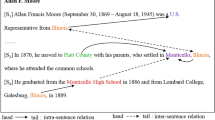Abstract
Document-level Relation Extraction is more challenging than its sentence-level counterpart, extracting unknown relational facts from a plain text at the document level. Studies have shown that the Transformer architecture models long-distance dependencies without regard to the syntax-level dependencies between tokens in the sequence, which hinders its ability to model long-range dependencies. Furthermore, the global information among relational triples and local information around entities is critical. In this paper, we propose a Dependency Syntax Transformer and Supervised Contrastive Learning model (DSTSC) for document-level relation extraction. Specifically, dependency syntax information guides Transformer to enhance attention between tokens with dependency syntax relation in the sequence. The ability of Transformer to model document-level dependencies is improved. Supervised contrastive learning with fusion knowledge captures global information among relational triples. Gaussian probability distributions are also designed to capture local information around entities. Our experiments on two document-level relation extraction datasets, CDR and GDA, have remarkable results.
Access this chapter
Tax calculation will be finalised at checkout
Purchases are for personal use only
Similar content being viewed by others
References
Beltagy, I., Lo, K., Cohan, A.: SciBERT: a pretrained language model for scientific text. In: EMNLP-IJCNLP 2019, 3–7 November 2019, pp. 3613–3618 (2019). https://doi.org/10.18653/v1/D19-1371
Christopoulou, F., Miwa, M., Ananiadou, S.: Connecting the dots: document-level neural relation extraction with edge-oriented graphs. In: EMNLP-IJCNLP 2019, pp. 4924–4935 (2019). https://doi.org/10.18653/v1/D19-1498
Guo, Z., Zhang, Y., Lu, W.: Attention guided graph convolutional networks for relation extraction. In: ACL 2019, pp. 241–251 (2019). https://doi.org/10.18653/v1/P19-1024
Kambhatla, N.: Combining lexical, syntactic, and semantic features with maximum entropy models for information extraction. In: Proceedings of the ACL Interactive Poster and Demonstration Sessions, pp. 178–181 (2004). https://aclanthology.org/P04-3022/
Khosla, P., et al.: Supervised contrastive learning. In: NIPS 2020, vol. 33, pp. 18661–18673 (2020). https://proceedings.neurips.cc/paper/2020/hash/d89a66c7c80a29b1bdbab0f2a1a94af8-Abstract.html
Le, H., Can, D., Dang, T.H., Tran, M., Ha, Q., Collier, N.: Improving chemical-induced disease relation extraction with learned features based on convolutional neural network. In: KSE, pp. 292–297 (2017). https://doi.org/10.1109/KSE.2017.8119474
Li, Z., Yang, Z., Xiang, Y., Luo, L., Sun, Y., Lin, H.: Exploiting sequence labeling framework to extract document-level relations from biomedical texts. BMC Bioinform. 21(1), 125 (2020). https://doi.org/10.1186/s12859-020-3457-2
Li, Z., Sun, Y., Zhu, J., Tang, S., Zhang, C., Ma, H.: Improve relation extraction with dual attention-guided graph convolutional networks. Neural Comput. Appl. 33(6), 1773–1784 (2021). https://doi.org/10.1007/s00521-020-05087-z
Nan, G., Guo, Z., Sekulic, I., Lu, W.: Reasoning with latent structure refinement for document-level relation extraction. In: ACL 2020, 5–10 July 2020, pp. 1546–1557 (2020). https://doi.org/10.18653/v1/2020.acl-main.141
Su, P., Peng, Y., Vijay-Shanker, K.: Improving BERT model using contrastive learning for biomedical relation extraction. In: BioNLP@NAACL-HLT 2021, 11 June 2021, pp. 1–10 (2021). https://doi.org/10.18653/v1/2021.bionlp-1.1
Sun, C., et al.: Chemical-protein interaction extraction via Gaussian probability distribution and external biomedical knowledge. Bioinformatics 36(15), 4323–4330 (2020). https://doi.org/10.1093/bioinformatics/btaa491
Vaswani, A., et al.: Attention is all you need. In: NIPS 2017, pp. 5998–6008 (2017). https://proceedings.neurips.cc/paper/2017/hash/3f5ee243547dee91fbd053c1c4a845aa-Abstract.html
Verga, P., Strubell, E., McCallum, A.: Simultaneously self-attending to all mentions for full-abstract biological relation extraction. In: NAACL-HLT, pp. 872–884 (2018). https://doi.org/10.18653/v1/n18-1080
Zheng, W., Lin, H., Liu, X., Xu, B.: A document level neural model integrated domain knowledge for chemical-induced disease relations. BMC Bioinform. 19(1), 1–12 (2018). https://doi.org/10.1186/s12859-018-2316-x
Zhou, H., Ning, S., Yang, Y., Liu, Z., Lang, C., Lin, Y.: Chemical-induced disease relation extraction with dependency information and prior knowledge. CoRR (2020). http://arxiv.org/abs/2001.00295
Zhou, W., Huang, K., Ma, T., Huang, J.: Document-level relation extraction with adaptive thresholding and localized context pooling. In: AAAI 2021, vol. 35, pp. 14612–14620 (2021). https://ojs.aaai.org/index.php/AAAI/article/view/17717
Acknowledgment
This work is supported by grant from the Natural Science Foundation of China (No. 62072070) and Social and Science Foundation of Liaoning Province (No. L20BTQ008).
Author information
Authors and Affiliations
Corresponding author
Editor information
Editors and Affiliations
Rights and permissions
Copyright information
© 2022 The Author(s), under exclusive license to Springer Nature Singapore Pte Ltd.
About this paper
Cite this paper
Yang, M., Zhang, Y., Banbhrani, S.K., Lin, H., Lu, M. (2022). Document-Level Relation Extraction with a Dependency Syntax Transformer and Supervised Contrastive Learning. In: Sun, M., et al. Knowledge Graph and Semantic Computing: Knowledge Graph Empowers the Digital Economy. CCKS 2022. Communications in Computer and Information Science, vol 1669. Springer, Singapore. https://doi.org/10.1007/978-981-19-7596-7_4
Download citation
DOI: https://doi.org/10.1007/978-981-19-7596-7_4
Published:
Publisher Name: Springer, Singapore
Print ISBN: 978-981-19-7595-0
Online ISBN: 978-981-19-7596-7
eBook Packages: Computer ScienceComputer Science (R0)




